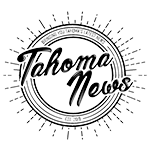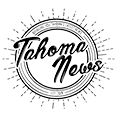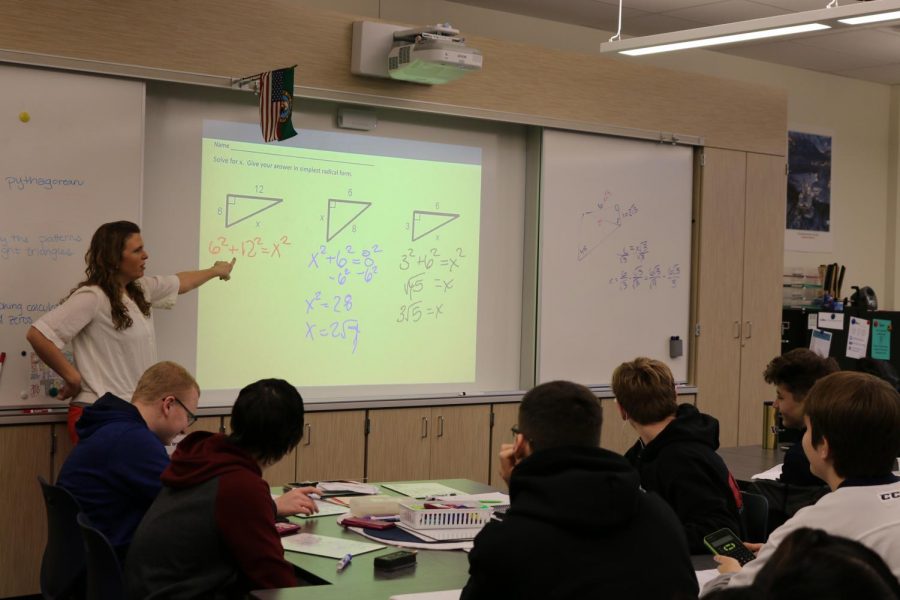Effective Teaching at Tahoma? Students Decide
Students give their opinion on what makes them want to come to school everyday
Students in Ms. Blay’s class attentively listen to her math lesson.
February 6, 2018
A healthy learning environment is what makes students want to come to school. However, with the new 8-period schedule, students are exposed to more teachers and different teaching styles. So what makes a teacher a ‘good teacher’?
Students have various opinions about what makes their teachers effective at Tahoma High School. Students voiced their opinion on what teachers should do to benefit their students to the best of their abilities.
In an anonymous survey of 38 Tahoma students, 100% of them feel like some teachers are better than others in the same subject. For example, one student could get Mr. X in math and another student could get Mr. Y and even though the material being taught is the exact same, Mr. X produces better grades than Mr. Y. In the same survey, 92% of students have felt like they could get a better grade in a class simply if they had a different teacher. But what do students at Tahoma believe makes a teacher more effective than another?
Senior Kaylee Hazelwood says that what makes or breaks a teacher is “passion, some teachers seem like they don’t want to be at school as much as others” In the aforementioned survey, only 39% of them felt like all of their teachers were passionate about their jobs.
According to TeachThought, they pose a question “Whether it be a teacher, a parent, or a friend…when someone is passionate we tend to listen closer, buy into what they are saying, and remember it later.”In the same article, Bill Smoot, an author who writes about classroom settings, says “Their passion is not only for the activity of teaching but also for the ends it serves. Great teachers have humility in knowing that they serve a purpose larger than themselves. Even when I interviewed teachers in whom I detected a touch of ego, it was clear that they leave their egos behind when they teach. Nor did I find anyone who cultivated disciples. What the best teachers ultimately give to their students is the ability to make their own way forward”.”
Gone are the days when students really liked teachers who didn’t care and let the class go wild. In the same survey of Tahoma students, students claim the best teachers have a clear lesson plan every day. Roughly 58% of the students who participated in the survey say that only some of their teachers fit this description.
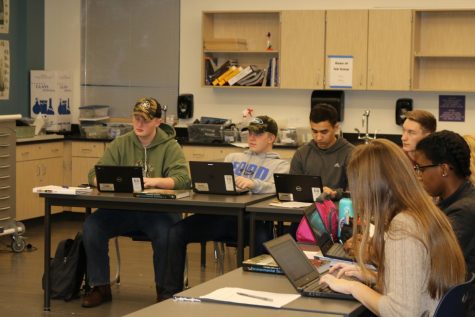
Ms. Hardtke’s AP Environmental Science students taking notes on the lesson.
According to the Australian Society for Evidence-Based Teaching (ASEBT), “The effect [of clear lesson plans] has on student results is 32% greater than the effect of holding high expectations for every student…” An easy way to tell if one’s teacher is being effective is if a student cannot quick;y say what the teacher’s lesson plan is, then the whole lesson will be unclear and be rendered as unproductive.
Junior Joanna Liggett believes that one of the worst teaching strategies is “teaching without an objective. The worst thing for a student is when they’re taking a test and they never learn how to respond to that problem.” She also feels like “some teachers also overwhelm students with material that’s not even going to be on the test.”
Having a clear and focused lesson plan is something to be valued. It lets the students prepare for the day and get into the right mindset to learn. Liggett says she really likes Senor Hipolito’s teaching style. “Everyday he would give you an organized handout with notes on it about the new concept you were going to learn that day. He made everything super interactive.”
In a study conducted by the Proceedings of the National Academy of Sciences of the United States of America, they found “that undergraduate students in classes with traditional stand-and-deliver lectures are 1.5 times more likely to fail than students in classes that use more stimulating, so-called active learning methods.” Therefore, teachers that are able to get their students’ engaged in their lessons, are less likely to have students fail the class.
A traditional classroom setting doesn’t prepare students for real-world scenarios. “Traditional training emphasizes individual student work and projects and is poor preparation for a student’s future endeavors, which are likely to include working on teams and collaborating with colleagues. Under this training model, students receive few opportunities to practice group dynamics and teamwork.” (classroom.synonym.com)
Freshman Rachel Davis believes that a “good teacher has to be able to listen. Teachers have to know what their students need to know and what questions they have so later on they can help as many students” to reach their full potential. “High school students need to know that they can share their opinions without being judged by adults, such as their teachers”
According to TeachThought, a teaching based news website, “The role of curiosity has been studied, but suffice to say that if a learner enters any learning activity with little to no natural curiosity, prospects for meaningful interaction with texts, media, and specific tasks are bleak.” Davis says it really helps when students ask questions because it lets the teachers “know what needs to be taught” which is akin to the TeachThought’s philosophy.
Without placing emphasis on building relationships between students and teachers, some students feel like it is counter-effective to their learning. Students like to feel comfortable around their teachers. Rachel claims that the best teachers “take the most time with every student to help them do their best and work with their individual needs.” Her statement is analogous to what Liggett claimed as well. The best teachers “make class something you want to go to because you know you will have fun while learning.”
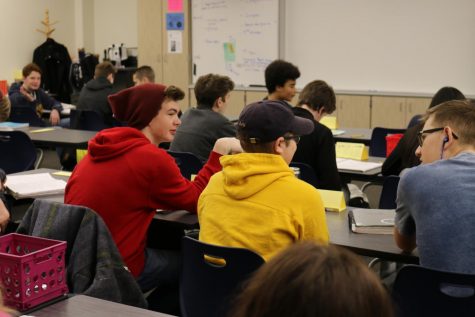
Sra. Victor’s students speaking Spanish with each other during a speaking activity.
Since there are so many teachers at Tahoma High School, students are exposed to various teaching styles. Some are more traditional and lecture based and some are more interactive. Some teachers are very focused on teaching simply for their students to pass the final and some are very focused on making sure their students are grasping concepts and strategies. Traditional teaching methods do not supplement what students feel like is the most effective for them. “A drawback of traditional training is that it inherently places the most value on standards, curriculum and passing tests as opposed to student-focused learning.” (classroom.synonym.com)
Another teaching method that students feel is effective is being able to work with other students. Kaylee Hazelwood says that one of the best teaching methods is not having to “take notes all the time and being able to to do group work.” Rachel Davis believes the same thing. She claims that “group work definitely does have its benefits” but it is important that a teacher can cater to a student’s individual needs as well.
The ASEBT gave their advice to teachers, saying “Group work is not new, and you can see it in every classroom. However, productive group work is rare. When working in groups, students tend to rely on the person who seems most willing and able to the task at hand. Psychologists call this phenomenon social loafing. To increase the productivity of your groups, you need to be selective about the tasks you assign to them and the individual role that each group member plays. You should only ask groups to do tasks that all group members can do successfully. You should also ensure each group member personally responsible for one step in the task.”
Students at Tahoma High School have shown trends in what they like in teachers. They enjoy an interactive learning environment, a good relationship with their teacher and passion in the classroom. If teachers experiment with what teaching methods worked for their individual classes and tried to stray away from traditional teaching methods, the passion for learning at Tahoma would rise exponentially.

